Frying is an antique cooking process which was employed by the Egyptians, but only a few people today can create fried foods well. Following a few simple rules to make crispy, light, and non-greasy fried food. From oil selection to temperature, breading to the proper pan, and frequent blunders to avoid, here are all of the criteria for excellent frying.
Crunchy, fragrant, and light, the ideal fried dish isn’t as tough to prepare as it appears. But frying is one among those cooking methods that can’t be acquired “by intuition”; how might you avoid getting it greasy? When should you add salt? Which plan should I choose? Should I use a Henny Penny pressure fryer? Here are all the answers to your queries about how to make delicious fried food.
What Oil to Use for Frying?
The first long-standing issue is, what kind of oil is best for frying? There are numerous answers to this subject, but one thing is certain: the most important rule is to examine the oil smoke point. The smoke point is the point in time that occurs when the oil starts decomposing, causing the oil to emit smoke as well as volatile substances that are deemed “probably carcinogenic to humans” (Group 2a) by the International Agency for Research on Cancer.
As a result, selecting the appropriate oil is critical, as it influences our guests’ health. Peanut oil (230 degrees Celsius) and more virgin olive oil (200 degrees Celsius) have the highest smoke points, whilst corn seed oil (140 degrees Celsius) and sunflower oil (170 degrees Celsius) have lower points. The recommended frying temperature ranges from 165 and 185 degrees Celsius; some items may fry at 140 degrees Celsius, while others require 180 degrees Celsius.
The Perfect Temperature for Frying: Finding the Sweet Spot
Whenever it is about cooking, there’s no doubt that frying is one of the most difficult methods to master. Not only should your ingredients be thoroughly coated and seasoned, but you should also keep an eye on the oil temperature. Too hot, & your meal will burn; too cold, and the food will get oily and undercooked. This is why determining the optimal temperature for frying is critical, and it all begins with comprehending the physics behind it. Fortunately, with a little testing and a trustworthy thermometer, you can identify that sweet spot wherein your foods are consistently crispy and tasty. So don’t be scared to heat things and get started; with a little practice, you’ll be cooking like a pro in no time.
Don’t Overcook
Have you tried Chickenjoy sans gravy? It isn’t fun. Fast food restaurants often overcook their fried chicken, making it dry and chewy. This is how they serve so much gravy: the extra moisture on top helps the chicken seem less like jerky. Most new cooks believe that if you finish up with golden, crispy food, you’ve done it correctly. However, when deep frying, you must also manage the meat inside. You need the outside to be crispy while the inside remains juicy. It is not one or the other. Getting the crispy exterior? Not an issue. Simply cook the crap out of it. Dip your chicken in hot oil till it’s nice and crusty. This is all there is to it.
Choose the Right Tools
When you deep-fry something, you use sufficient hot oil to kill your adversaries. To successfully navigate the perils of hot oil, you must have the proper instruments. If you fry with a spatula or a large spoon, you’re sending yourself to the ER. Tongs can easily grip most foods. They may help you in navigating around food if they collide, similar to people on the LRT.
Excellent when your pan is packed. The oil skimmer provides a lot of adaptability. Its large, round surface allows you to effortlessly lift little fried foods (for example, chicken karaage). The same wide surface helps you to gather meals with huge surface areas (for example, whole fish).
Dry your Food
Something wet won’t get crispy. Water functions as a barrier, preventing oil from crisping up your meal. As long as water remains on the surface, heated oil will attempt to remove it first. This explains why oil splatters whenever wet food is dropped into hot oil. The hot oil’s rapid flow causes moisture to rise to the surface. The small water bubbles compete with the heated oil and ultimately lose. So, once wet food comes into touch with oil, all of the hot oil will be focused on dispersing the water first. This calls for a significant amount of time and work.
Final Words
Fried foods are an excellent way to add thrill and zest to any dish! With the proper equipment, supplies, and skills, you’ll become a skilled fryer in no time. Visit thegromix for more interesting articles.




